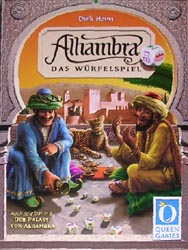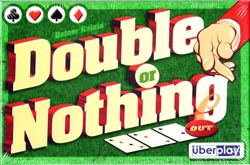 This week, Nige brought along Container, a game he’d just picked up that was designed by Thomas Ewert and Franz-Benno Delonge and published by Valley Games. This is a game that simulates a simple supply and demand system, based around production, warehousing and shipping of some unnamed merchandise.
This week, Nige brought along Container, a game he’d just picked up that was designed by Thomas Ewert and Franz-Benno Delonge and published by Valley Games. This is a game that simulates a simple supply and demand system, based around production, warehousing and shipping of some unnamed merchandise.
As we decided not to play with the beginner’s variant, we knew money was going to be very tight and that drawing loans was a bad idea. Nevertheless, all of us were forced to take at least one loan eventually. Initially, I chose to build a second and then third warehouse to try and attract people to more efficient loading of ships. However, the group-think reaction of refusing to use my dock lead me to having a number of turns with little to do due to lack of cash, until I broke down and took a loan – at which stage people decided that was enough screw tightening and the containers started to flow.
Our caution over cash lead to no profit being made on production and warehousing as people refused to pay more than the minimum price for stuff. Mark K tried to use his monopoly on one type of machine to set a medium price but, once things became critical, I broke his monopoly by building the same machine and bringing the price down. So, the only real money to made was in the island bidding. Seeing which shipments players really wanted for themselves was an interesting challenge but I managed to force John and Nige to pay more than they expected to by setting a relatively high bid myself. Eventually, Nige forced the end of the game by exhausting the supply of two container types as he judged he was far enough in the lead. He was just right because my next turn would probably have netted me enough cash from an island shipment to just go past him.
Container was a good game that suffered a little from the profit being made from just one aspect of the production chain. If the same group could be persuaded to take a different collective view, it will be interesting to see how the game plays differently but whether such a change is likely, I don’t know. However, a nice game that I really enjoyed playing.

 This week’s session of the Shrewsbury Boardgames Club will be on Friday 27th June at Garry’s house.
This week’s session of the Shrewsbury Boardgames Club will be on Friday 27th June at Garry’s house. Got home tonight to find the latest issue of Spielbox waiting for me. The most interesting inclusion is the farmer sheet, an accessory for Agricola. It contains 70 stickers to put on the round person pieces. 35 stickers show an adult for the front side of the pieces, the other 35 the corresponding juniors for the rear side (and one or two of the comparisons between junior and adult characters are a little curious). I just need the game itself to turn up now – hopefully, sometime this month.
Got home tonight to find the latest issue of Spielbox waiting for me. The most interesting inclusion is the farmer sheet, an accessory for Agricola. It contains 70 stickers to put on the round person pieces. 35 stickers show an adult for the front side of the pieces, the other 35 the corresponding juniors for the rear side (and one or two of the comparisons between junior and adult characters are a little curious). I just need the game itself to turn up now – hopefully, sometime this month. This week, we played the dice version of the 2003 Spiel des Jahres, Alhambra. However, the only real similarities with the board game are the scoring mechanism and the theme. Alhambra – The Dice Game was designed by Dirk Henn and published by Queen Games.
This week, we played the dice version of the 2003 Spiel des Jahres, Alhambra. However, the only real similarities with the board game are the scoring mechanism and the theme. Alhambra – The Dice Game was designed by Dirk Henn and published by Queen Games. After the disaster that was Alhambra – The Dice Game, we only had time for a short game to finish and we picked this push your luck card game from Reiner Knizia, which is published in Germany by Piatnik.
After the disaster that was Alhambra – The Dice Game, we only had time for a short game to finish and we picked this push your luck card game from Reiner Knizia, which is published in Germany by Piatnik. Just a reminder that the second
Just a reminder that the second